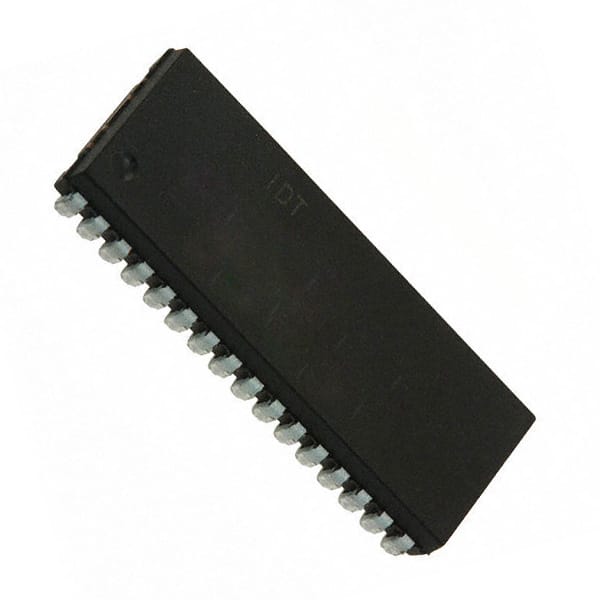Viz Specifikace pro podrobnosti o produktu.

IDT71V124SA20Y
Product Overview
- Category: Integrated Circuit (IC)
- Use: Memory device
- Characteristics: High-speed, low-power, synchronous static random-access memory (SRAM)
- Package: 44-pin plastic thin small outline package (TSOP)
- Essence: Provides fast and reliable data storage and retrieval capabilities
- Packaging/Quantity: Available in tape and reel packaging, quantity varies based on customer requirements
Specifications
- Organization: 128K x 8 bits
- Voltage Supply: 3.3V
- Access Time: 20ns
- Operating Temperature Range: -40°C to +85°C
- Standby Current: 10µA (typical)
- Package Dimensions: 12.8mm x 20.4mm x 1.0mm
Detailed Pin Configuration
The IDT71V124SA20Y has a total of 44 pins. The pin configuration is as follows:
- A0-A16: Address Inputs
- DQ0-DQ7: Data Inputs/Outputs
- WE: Write Enable
- OE: Output Enable
- CE: Chip Enable
- UB/LB: Upper Byte/Lower Byte Control
- VCC: Power Supply
- GND: Ground
(Note: The remaining pins are not listed here for brevity.)
Functional Features
- High-speed operation: The IDT71V124SA20Y offers a fast access time of 20ns, allowing for quick data retrieval.
- Low power consumption: With a standby current of only 10µA, this memory device helps conserve energy.
- Synchronous operation: The device synchronizes its operations with an external clock signal, ensuring reliable data transfer.
- Easy integration: The 44-pin TSOP package allows for easy integration into various electronic systems.
Advantages and Disadvantages
Advantages: - High-speed operation enables efficient data processing. - Low power consumption helps prolong battery life in portable devices. - Synchronous operation ensures reliable data transfer. - Easy integration due to the compact TSOP package.
Disadvantages: - Limited storage capacity compared to other memory devices. - Relatively higher cost per unit compared to some alternative models.
Working Principles
The IDT71V124SA20Y is a synchronous SRAM that stores and retrieves data using an array of flip-flops. It operates by synchronizing its internal operations with an external clock signal. When the chip enable (CE) and output enable (OE) signals are active, the device can read or write data based on the address inputs provided. The upper byte/lower byte control (UB/LB) pins allow for byte-level access to the memory.
Detailed Application Field Plans
The IDT71V124SA20Y is commonly used in applications that require fast and reliable data storage and retrieval. Some specific application fields include:
- Computer Systems: Used as cache memory in high-performance computers to enhance data access speed.
- Networking Equipment: Employed in routers and switches to store routing tables and packet buffers.
- Telecommunications: Utilized in base stations and network switches for storing call data and routing information.
- Industrial Control Systems: Integrated into programmable logic controllers (PLCs) for storing program instructions and data.
- Automotive Electronics: Used in automotive control units for storing critical data and firmware.
Detailed and Complete Alternative Models
- IDT71V124SA15Y: Similar to IDT71V124SA20Y but with a faster access time of 15ns.
- IDT71V124SA25Y: Similar to IDT71V124SA20Y but with a slower access time of 25ns.
- IDT71V124SA10Y: Similar to IDT71V124SA20Y but with a lower voltage supply of 2.5V.
(Note: The list above includes only a few alternative models for reference.)
This concludes the encyclopedia entry for the IDT71V124SA20Y, providing an overview of its product details, specifications, pin configuration, functional features, advantages and disadvantages, working principles, application field plans, and alternative models.
Seznam 10 běžných otázek a odpovědí souvisejících s aplikací IDT71V124SA20Y v technických řešeních
Sure! Here are 10 common questions and answers related to the application of IDT71V124SA20Y in technical solutions:
Q: What is IDT71V124SA20Y? A: IDT71V124SA20Y is a high-speed, low-power CMOS static RAM (SRAM) chip manufactured by Integrated Device Technology (IDT).
Q: What is the capacity of IDT71V124SA20Y? A: IDT71V124SA20Y has a capacity of 1 megabit (128 kilobytes) organized as 131,072 words by 8 bits.
Q: What is the operating voltage range for IDT71V124SA20Y? A: The operating voltage range for IDT71V124SA20Y is typically between 4.5V and 5.5V.
Q: What is the access time of IDT71V124SA20Y? A: IDT71V124SA20Y has an access time of 20 nanoseconds (ns), meaning it takes approximately 20 ns to read or write data.
Q: Can IDT71V124SA20Y be used in battery-powered devices? A: Yes, IDT71V124SA20Y is designed to operate at low power and can be used in battery-powered devices.
Q: Is IDT71V124SA20Y compatible with standard SRAM interfaces? A: Yes, IDT71V124SA20Y is compatible with industry-standard asynchronous SRAM interfaces, making it easy to integrate into existing designs.
Q: Does IDT71V124SA20Y support multiple read and write operations simultaneously? A: No, IDT71V124SA20Y is a single-port SRAM, meaning it can perform either a read or write operation at a time.
Q: Can IDT71V124SA20Y operate in harsh environments? A: IDT71V124SA20Y is not specifically designed for harsh environments and may require additional protection if used in such conditions.
Q: What are some typical applications of IDT71V124SA20Y? A: IDT71V124SA20Y is commonly used in various technical solutions, including telecommunications equipment, networking devices, industrial control systems, and automotive electronics.
Q: Are there any special considerations when designing with IDT71V124SA20Y? A: It is important to follow the datasheet guidelines provided by IDT for proper power supply decoupling, signal integrity, and timing requirements to ensure reliable operation with IDT71V124SA20Y.
Please note that these answers are general and may vary depending on specific design requirements and application scenarios.

